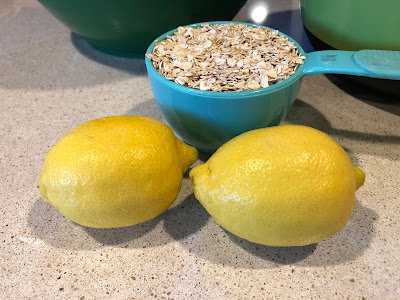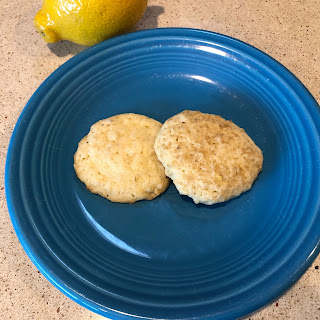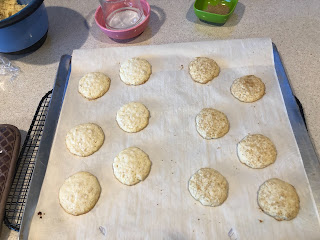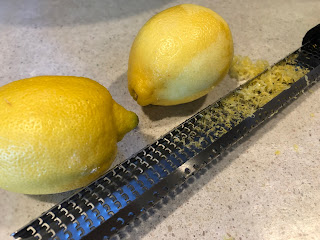
Celebrate citrus season with two versions of these little treats

(Photos by Kathy Morrison) |
Ask anyone this time of year whether they'd like a cookie, and they're bound to look at you like you're crazy. So soon after the holidays? It's diet season, not baking season. And yet ...
It's also citrus season, and a little baked treat is a great way to enjoy the fruit. Lemon cookies, especially lemon bars, are among the most popular types at gatherings. But the bars, as wonderful as they are, rank as complicated and rich in my baking experience.
Much easier is this little lemon and whole-grain oats cookie I found in a secondhand cookbook that a dear friend gave me. "The Wellesley Cookie Exchange Cookbook" was printed in 1986, edited by Susan Mahnke Peery, then-food editor of Yankee magazine.
The recipe, however, is even older. Peery herself contributed it to the collection, with the note, "This recipe is on a yellowed newspaper clipping I've had for years. The cookies are delicate and delicious."

This definitely is a celebration of lemon: The unbaked dough smells so good that you might be tempted to eat it raw (but please don't).
It also is full of butter, so I decided to try a version using Earth Balance buttery sticks, a vegan product which comes close to the flavor of butter but is much lower in cholesterol and saturated fat. I discovered, however, that it's much higher in sodium than salted butter, which I don't generally use, so the recipe was adjusted accordingly, eliminating any added salt. I also reduced the amount of sugar in the "healthier" version.
A note on the oats: Quick oats, which are partially cooked and should not be confused with "instant" oatmeal, have the same nutritional benefit as old-fashioned rolled oats. Both have 4 g of fiber and 5 g protein per 1/2 cup (40g). I used quick oats in both recipes because it tends to blend better, but either is fine. Also, in the Earth Balance version, some of the unbleached flour was subbed out for oat flour (which is just ground-up oats).
Both versions of the recipe follow. How did they compare? The "healthier" dough is a little stickier; I think the oat flour helps keep it from spreading too much, since the two versions baked identically. When it came to taste, the butter cookie was a little crisper, the other a touch more cakey, but they both were delicious.
Each recipe makes a lot of little cookies; the amounts can easily be halved.
Healthier lemon oatmeal cookies
Adapted by Kathy Morrison

|
Makes 6 dozen cookies, about 2 1/4 inches in diameter
Ingredients:
2 cups unbleached flour
3/4 cup oat flour
2 teaspoons baking powder
1 cup (2 sticks) Earth Balance buttery sticks, plus a little for greasing the flattening glass (see instructions)
1 1/2 cups granulated sugar
2 eggs
2 teaspoons grated lemon zest (grate 2 lemons; you'll have a little extra)
3 tablespoons fresh lemon juice
1 cup quick oats
Sugar for topping, such a demerara or sanding sugar, optional
Lemon zest for topping, optional (see note below)
Instructions:
Stir together the flours and baking powder in a small bowl. In a large bowl, cream the Earth Balance and sugar. Add the eggs, beating well. Beat in the lemon zest and juice. Gradually add the flour mixture, then stir in the oats.
Chill dough thoroughly, at least two hours.
Preheat oven to 375 degrees. Prepare cookie sheets (I use insulated ones for this recipe) by greasing or, my preference, covering with parchment paper.
Roll level tablespoons of dough into balls, or use a 1-tablespoon cookie scoop to scoop out balls of dough. Place dough balls on the prepared cookie sheet, allowing 2 inches between each cookie.
Using a flat-bottomed glass or custard cup that has been greased and dipped in preferred sugar, flatten each ball to 1/4-inch thickness, dipping glass into sugar each time.
Bake for 8 to 10 minutes, until cookies are lightly brown around the edges. Very cold dough may take another minute or 2 more.
Note: The topping sugar can be eliminated, but it does provide a nice crunch. If you're skipping it, wet your fingers and use them to flatten the cookies. If you want to boost the lemon taste even more, stir a little of the leftover lemon zest into the topping sugar before flattening the cookies.
Original lemon oatmeal cookies
Adapted slightly by Kathy Morrison
Makes 6 dozen cookies, about 2 1/4 inches in diameter

the lemon rind. |
Ingredients:
2 3/4 cups unbleached flour
2 teaspoons baking powder
1/2 teaspoon salt
1 cup (2 sticks) unsalted butter, plus a little more to grease the flattening glass (see instructions)
2 cups granulated sugar
2 eggs
2 teaspoons grated lemon zest (grate 2 lemons; you'll have a little extra)
3 tablespoons fresh lemon juice
1 cup quick oats
Sugar for topping, such a demerara or sanding sugar, optional
Lemon zest for topping, optional (see note below)
Instructions:
Stir together the flour, baking powder and salt in a small bowl. In a large bowl, cream the butter and sugar. Add the eggs, beating well. Beat in the lemon zest and juice. Gradually add the flour mixture, then stir in the oats.
Chill dough thoroughly, at least two hours.
Preheat oven to 375 degrees. Prepare cookie sheets (I use insulated ones for this recipe) by greasing or, my preference, covering with parchment paper.
Roll level tablespoons of dough into balls, or use a 1-tablespoon cookie scoop to scoop out balls of dough. Place dough balls on the prepared cookie sheet, allowing 2 inches between each cookie.
Using a flat-bottomed glass or custard cup that has been greased and dipped in preferred sugar, flatten each ball to 1/4-inch thickness, dipping glass into sugar each time.
Bake for 8 to 10 minutes, until cookies are lightly brown around the edges. Very cold dough may take another minute or 2.
Note: The topping sugar can be eliminated, but it does provide a nice crunch. If you're skipping it, wet your fingers and use them to flatten the cookies. If you want to boost the lemon taste even more, stir a little of the leftover lemon zest into the topping sugar before flattening the cookies.
Comments
0 comments have been posted.Sacramento Digs Gardening to your inbox.
Sites We Like
Garden Checklist for week of May 12
Get your gardening chores and irrigation done early in the day before temperatures rise.
* Plant, plant, plant! It’s prime planting season in the Sacramento area. Time to set out those tomato transplants along with peppers and eggplants. Pinch off any flowers on new transplants to make them concentrate on establishing roots instead of setting premature fruit.
* Direct-seed melons, cucumbers, summer squash, corn, radishes, pumpkins and annual herbs such as basil.
* Harvest cabbage, lettuce, peas and green onions. This heat will cause leafy greens and onions to flower; pick them before they bolt.
* In the flower garden, direct-seed sunflowers, cosmos, salvia, zinnias, marigolds, celosia and asters.
* Plant dahlia tubers. Other perennials to set out include verbena, coreopsis, coneflower and astilbe.
* Transplant petunias, marigolds and perennial flowers such as astilbe, columbine, coneflowers, coreopsis, dahlias, rudbeckia and verbena.
* Keep an eye out for slugs, snails, earwigs and aphids that want to dine on tender new growth.
* Feed summer bloomers with a balanced fertilizer.
* For continued bloom, cut off spent flowers on roses as well as other flowering plants.
* Got fruit trees? If you haven't already done so, thin orchard fruit such as apples, peaches, pears, pluots and plums before they grow too heavy, breaking branches or even splitting the tree. Leave the largest fruit on the branch, culling the smaller ones, and allow for 5 to 6 inches (or a hand's worth) between each fruit.
* Thin grape bunches, again leaving about 6 inches between them. For the remaining bunches, prune off the "tail" end, about the bottom third of the bunch, so that the plant's energy is concentrated in the fruit closest to the branch.
* As spring-flowering shrubs finish blooming, give them a little pruning to shape them, removing old and dead wood. Lightly trim azaleas, fuchsias and marguerites for bushier plants.
* Add mulch to the garden to help keep that precious water from evaporating. Mulch also cuts down on weeds. But don’t let it mound around the stems or trunks of trees or shrubs. Leave about a 6-inch to 1-foot circle to avoid crown rot or other problems.